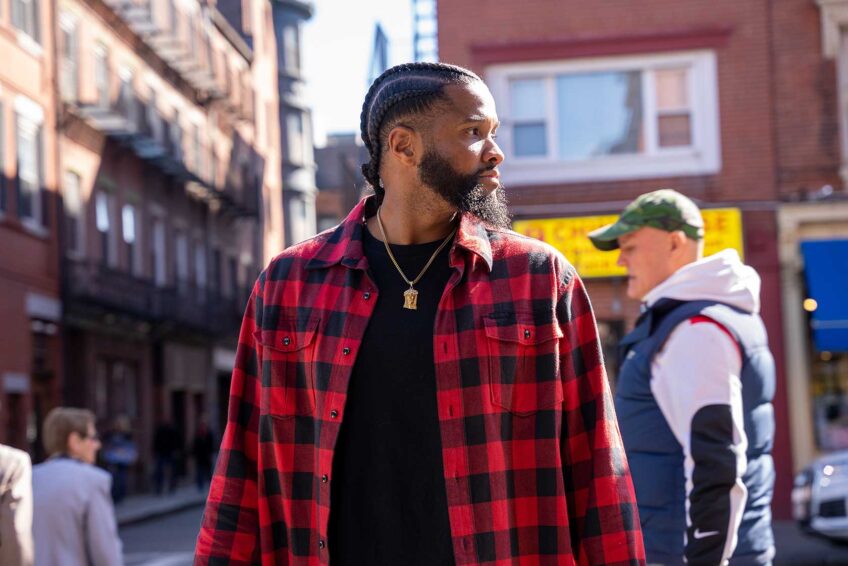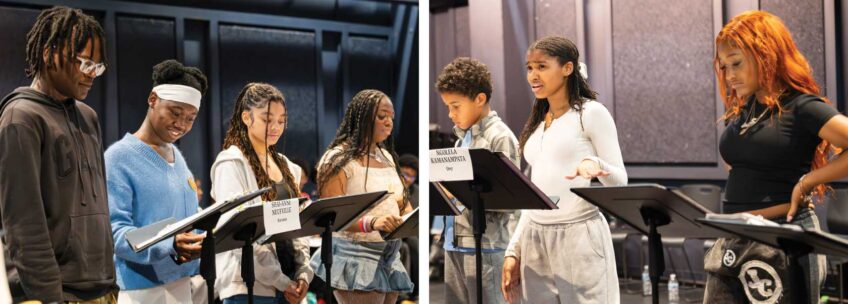
A gem of a show is on stage at the Boston Center for the Arts through February 6: The SpeakEasy Stage Company production of the musical “Violet.”
Composed by Jeanine Tesori with lyrics and book by Brian Crawley, “Violet” is inspired by the short story “The Ugliest Pilgrim,” by North Carolina author Doris Betts (1932-2012).
First mounted in 1997 as an Off-Broadway production, “Violet” takes place in September 1964. Violet, age 23, travels by bus almost 1,000 miles from her home in the mountain town of Spruce Pine, NC, to Tulsa, OK. Her goal is to seek out a televangelist who she believes will heal her disfigured face, which was scarred when her father’s ax blade accidently broke loose and struck her.
Although she is strong, Violet has had more than her share of sorrow. Her mother died when she was a child and her father died three years ago. She longs for a new life.
Accustomed to other kids calling her “Axe-head” and “Freak-face,” Violet wants to be scar-free and also covets the full lips and flawless skin of movie stars she admires in magazines.
As fellow passengers and bus drivers meet Violet, they react to her disfigured face with a variety of exclamations such as “oooh,” “oh!” and “wow.” “I’m a long way from pretty,” she acknowledges, but adds that in a few days, she will return a new woman.
In the SpeakEasy production, the audience does not see Violet’s scar, only the unmarked, unremarkable, and pleasant face of the actress who plays her — Boston University graduate Alison McCartan, who embodies her character’s grit, pain and compassion.
Viewers see Violet as she is, not as she sees herself.
At stops along the way — in Kingsport, Nashville and Memphis and then in the Oklahoma towns of Fort Smith and Tulsa — Violet gradually comes to see herself in a new way.

Author: Glenn Perry PhotographyDan Belnavis, Alison McCartan, and Nile Scott Hawver.
Travelers in time
Violet’s bus companions have burdens of their own. The chatty, kind Old Lady is moving into the house of her son, whose rambunctious children are “like squirrels.” Among the passengers she befriends are two young soldiers, the manly but introverted Flick, an African American; and Monty, who is white and a self-styled ladies man.
At each stop, Violet’s relationships with the men deepen and she comes to a healing give-and-take of a different kind than she sought. Without striking a single false or saccharine note, the production illuminates its true subject: the halting fits and starts with which human love can grow and heal people.
SpeakEasy Artistic Director Paul Daigneault directs the production, which over a fast-moving hour and a half without intermission draws the audience into Violet’s world, and does so from the start.
Eric Levenson designed the sleek, slightly surreal art deco set, with its looming Greyhound Bus icon. Transforming the everyday scene of a bus waiting room, the versatile, evocative set lets the audience fill in the details and suits a story that toggles between Violet’s present and her flashbacks to a dead father and a younger self.
Right away introducing the dual pulls of the present and past is Young Violet, in a wondrous performance by 12-year old actress Audree Hedequist. A skinny girl wearing a simple little dress, her Young Violet is tough and plain, and her stride and set face convey fierce will. Her flat, sweet voice evokes the Appalachian folk music tradition as she belts a song that mingles lyrical and everyday language.
Ever faithful to their characters and situations, the actors make astonishingly natural shifts between speech and song, a credit to Tesori and Crawley as well as the cast and the musicians.
Matthew Stern is music director and also the pianist in the show’s seven-member ensemble. Performing on stage, the musicians are partly visible behind a panel.
The music at each stop revels in each town’s distinctive musical style: from a country and western song to Memphis R&B and, in Tulsa, a performance by a full gospel choir.
Charles Schoonmaker’s expressive costumes evoke the era as well as individuals, with ladylike outfits from hats to heels for female passengers except Violet, who wears a more rustic ensemble. Clothing also conjures a magical musical apparition as a trio of Radio Singers, in matching cowboy garb from hats to boots, croon in unison—a scene of visual and aural harmony.
Karen Perlow designed the sensitive lighting, which turns the set from a bus station into a dance hall and then a church; in close-up scenes, a character’s doubt, discovery, wariness or tenderness are illuminated.
Ensemble excellence
Each member of the show’s fabulous cast performs with heart and conviction. As Violet’s father, Michael Mendiola is subtle, tender and restrained — entirely credible as a man who raises a strong and smart daughter on his own. Nile Scott Hawver as Monty conveys his character’s bravado and growing tenderness. Daniel Belnavis as Flick is earnest, convincing as he ventures beyond his privacy to seek her trust.
Kathy St. George is a petite scene-stealer as the Old Lady and later as the Hotel Hooker. Carolyn Saxon is commanding as Lula, a gospel singer. John F. King is amazing as the dapper, smooth-talking but basically sincere Preacher who is ablaze during his service but after the show, droops — just another guy exhausted by a hard day’s work.
David Connolly lends a light but effective choreographic touch. A simple waltz begins a tentative coupling. As a bus takes off, the passengers lean as one, mimicking the sensation of a bus turning a corner.
The show has its share of thrilling ensemble numbers as well as scenes of stirring intimacy and revelation.
As the journey gets underway, people board the bus — a row of chairs — with black passengers taking seats in the back. While Violet and the Old Lady chat, a low hum rises from the seated passengers and grows into a euphoric traveling anthem.
A memorable flashback unfolds at the first stop, as Violet sits at a table to play draw poker with her new friends Monty and Flick. Alongside them, Young Violet reluctantly sits down at a table for a lesson in draw poker from her father, who sees it as a way to teach her arithmetic. He calls out hands in rhythmic, rhyming phrases that ascend into a chant-like song. As she learns the game and its lingo, her reluctance yields to pride and she sings along with her father. Meanwhile, her words and gestures are echoed by Violet, who is outplaying the soldiers, and joins in the song.
Violet arrives at the Preacher’s church in time for an all-out gospel performance. Accompanying the marvelous soloist, Lula, and the Preacher, who vibrates with strobe-light-speed euphoria, are 11 singers from Greater Boston gospel choirs (In the course of its run, the production will draw more than 100 singers from 11 choirs).
When the service ends, Violet implores the Preacher to heal her. He tries to dismiss her and, failing that, points out her false hope in his power. “Your scar is already healed,” he tells her. “It’s not going anywhere. You need to make your peace with that.”
Violet ignores his good advice. Her true healing comes later, back at the bus station.






